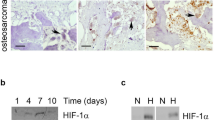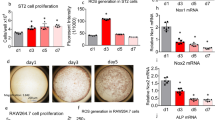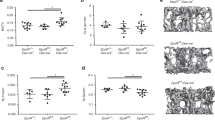Abstract
Osteoclasts are multinucleated haematopoietic cells that resorb bone. Increased osteoclast activity causes osteoporosis, a disorder resulting in a low bone mass and a high risk of fractures1. Increased osteoclast size and numbers are also a hallmark of other disorders, such as Paget’s disease and multiple myeloma2. The protein c-Fos, a component of the AP-1 transcription factor complex, is essential for osteoclast differentiation3. Here we show that the Fos-related protein Fra-2 controls osteoclast survival and size. The bones of Fra-2-deficient newborn mice have giant osteoclasts, and signalling through leukaemia inhibitory factor (LIF) and its receptor is impaired. Similarly, newborn animals lacking LIF have giant osteoclasts, and we show that LIF is a direct transcriptional target of Fra-2 and c-Jun. Moreover, bones deficient in Fra-2 and LIF are hypoxic and express increased levels of hypoxia-induced factor 1α (HIF1α) and Bcl-2. Overexpression of Bcl-2 is sufficient to induce giant osteoclasts in vivo, whereas Fra-2 and LIF affect HIF1α through transcriptional modulation of the HIF prolyl hydroxylase PHD2. This pathway is operative in the placenta, because specific inactivation of Fra-2 in the embryo alone does not cause hypoxia or the giant osteoclast phenotype. Thus placenta-induced hypoxia during embryogenesis leads to the formation of giant osteoclasts in young pups. These findings offer potential targets for the treatment of syndromes associated with increased osteoclastogenesis.
This is a preview of subscription content, access via your institution
Access options
Subscribe to this journal
Receive 51 print issues and online access
$199.00 per year
only $3.90 per issue
Buy this article
- Purchase on SpringerLink
- Instant access to full article PDF
Prices may be subject to local taxes which are calculated during checkout




Similar content being viewed by others
References
Karsenty, G. & Wagner, E. F. Reaching a genetic and molecular understanding of skeletal development. Dev. Cell 2, 389–406 (2002)
Ehrlich, L. A. & Roodman, G. D. The role of immune cells and inflammatory cytokines in Paget’s disease and multiple myeloma. Immunol. Rev. 208, 252–266 (2005)
Grigoriadis, A. E. et al. c-Fos: a key regulator of osteoclast–macrophage lineage determination and bone remodeling. Science 266, 443–448 (1994)
Karreth, F., Hoebertz, A., Scheuch, H., Eferl, R. & Wagner, E. F. The AP1 transcription factor Fra2 is required for efficient cartilage development. Development 131, 5717–5725 (2004)
Eferl, R., Zenz, R., Theussl, H. C. & Wagner, E. F. Simultaneous generation of fra-2 conditional and fra-2 knock-out mice. Genesis 45, 447–451 (2007)
Ware, C. B. et al. Targeted disruption of the low-affinity leukemia inhibitory factor receptor gene causes placental, skeletal, neural and metabolic defects and results in perinatal death. Development 121, 1283–1299 (1995)
Sims, N. A. et al. Glycoprotein 130 regulates bone turnover and bone size by distinct downstream signaling pathways. J. Clin. Invest. 113, 379–389 (2004)
Kawasaki, K. et al. Osteoclasts are present in gp130-deficient mice. Endocrinology 138, 4959–4965 (1997)
Hsu, L. W. & Heath, J. K. Identification of two elements involved in regulating expression of the murine leukaemia inhibitory factor gene. Biochem. J. 302, 103–110 (1994)
Martens, J. H. et al. The profile of repeat-associated histone lysine methylation states in the mouse epigenome. EMBO J. 24, 800–812 (2005)
Bakiri, L., Matsuo, K., Wisniewska, M., Wagner, E. F. & Yaniv, M. Promoter specificity and biological activity of tethered AP-1 dimers. Mol. Cell. Biol. 22, 4952–4964 (2002)
Escary, J. L., Perreau, J., Dumenil, D., Ezine, S. & Brulet, P. Leukaemia inhibitory factor is necessary for maintenance of haematopoietic stem cells and thymocyte stimulation. Nature 363, 361–364 (1993)
Stewart, C. L. et al. Blastocyst implantation depends on maternal expression of leukaemia inhibitory factor. Nature 359, 76–79 (1992)
Lagasse, E. & Weissman, I. L. Enforced expression of Bcl-2 in monocytes rescues macrophages and partially reverses osteopetrosis in op/op mice. Cell 89, 1021–1031 (1997)
McGill, G. G. et al. Bcl2 regulation by the melanocyte master regulator Mitf modulates lineage survival and melanoma cell viability. Cell 109, 707–718 (2002)
Egle, A., Harris, A. W., Bath, M. L., O’Reilly, L. & Cory, S. VavP-Bcl2 transgenic mice develop follicular lymphoma preceded by germinal center hyperplasia. Blood 103, 2276–2283 (2004)
Sasabe, E., Tatemoto, Y., Li, D., Yamamoto, T. & Osaki, T. Mechanism of HIF-1α-dependent suppression of hypoxia-induced apoptosis in squamous cell carcinoma cells. Cancer Sci. 96, 394–402 (2005)
Arnett, T. R. et al. Hypoxia is a major stimulator of osteoclast formation and bone resorption. J. Cell. Physiol. 196, 2–8 (2003)
Schipani, E. et al. Hypoxia in cartilage: HIF-1α is essential for chondrocyte growth arrest and survival. Genes Dev. 15, 2865–2876 (2001)
Adamopoulos, I. E., Xia, Z., Lau, Y. S. & Athanasou, N. A. Hepatocyte growth factor can substitute for M-CSF to support osteoclastogenesis. Biochem. Biophys. Res. Commun. 350, 478–483 (2006)
Utting, J. C. et al. Hypoxia inhibits the growth, differentiation and bone-forming capacity of rat osteoblasts. Exp. Cell Res. 312, 1693–1702 (2006)
Berra, E., Ginouves, A. & Pouyssegur, J. The hypoxia-inducible-factor hydroxylases bring fresh air into hypoxia signalling. EMBO Rep. 7, 41–45 (2006)
Takeda, K. et al. Placental but not heart defects are associated with elevated hypoxia-inducible factor α levels in mice lacking prolyl hydroxylase domain protein 2. Mol. Cell. Biol. 26, 8336–8346 (2006)
Schipani, E. Hypoxia and HIF-1α in chondrogenesis. Ann. NY Acad. Sci. 1068, 66–73 (2006)
Jeong, C. H. et al. Hypoxia-inducible factor-1α inhibits self-renewal of mouse embryonic stem cells in vitro via negative regulation of the leukemia inhibitory factor–STAT3 pathway. J. Biol. Chem. 282, 13672–13679 (2007)
Ivanov, S. V., Salnikow, K., Ivanova, A. V., Bai, L. & Lerman, M. I. Hypoxic repression of STAT1 and its downstream genes by a pVHL/HIF-1 target DEC1/STRA13. Oncogene 26, 802–812 (2007)
Stephanou, A., Brar, B. K., Knight, R. A. & Latchman, D. S. Opposing actions of STAT-1 and STAT-3 on the Bcl-2 and Bcl-x promoters. Cell Death Differ. 7, 329–330 (2000)
Dagoneau, N. et al. Null leukemia inhibitory factor receptor (LIFR) mutations in Stuve–Wiedemann/Schwartz–Jampel type 2 syndrome. Am. J. Hum. Genet. 74, 298–305 (2004)
Brandwood, C. P. et al. Apoptatic gene expression in Paget's disease: a possible role for Bcl-2. J. Pathol. 201, 504–512 (2003)
Clausen, B. E., Burkhardt, C., Reith, W., Renkawitz, R. & Forster, I. Conditional gene targeting in macrophages and granulocytes using LysMcre mice. Transgenic Res. 8, 265–277 (1999)
Tallquist, M. D. & Soriano, P. Epiblast-restricted Cre expression in MORE mice: a tool to distinguish embryonic vs. extra-embryonic gene function. Genesis 26, 113–115 (2000)
Parfitt, A. M. et al. Bone histomorphometry: standardization of nomenclature, symbols, and units. Report of the ASBMR Histomorphometry Nomenclature Committee. J. Bone Miner. Res. 2, 595–610 (1987)
Filgueira, L. Fluorescence-based staining for tartrate-resistant acidic phosphatase (TRAP) in osteoclasts combined with other fluorescent dyes and protocols. J. Histochem. Cytochem. 52, 411–414 (2004)
Bakiri, L. et al. Role of heterodimerization of c-Fos and Fra1 proteins in osteoclast differentiation. Bone 40, 867–875 (2007)
Acknowledgements
We thank E. Schipani for providing protocols and reagents for hypoxia stainings; A. Schleiffer and A. Souabni for experimental advice; and A. Grigoriadis, C. Hartmann, T. Jenuwein, R. Johnson and M. Sibilia for numerous suggestions and critical reading of the manuscript. The Institute of Molecular Pathology is funded by Boehringer Ingelheim and this work was supported by the Austrian Industrial Research Promotion Fund. L.B. is partly funded by the NoE Cells into Organs (LSHM-CT-2003-504468). A.H. was the recipient of an EMBO and Marie Curie long-term fellowship. M.A. is funded by the German Research Community (DFG).
Author information
Authors and Affiliations
Corresponding author
Supplementary information
Supplementary Information
The file contains Supplementary Figures 1-6 with Legends, Supplementary Methods and additional references. (PDF 3633 kb)
Rights and permissions
About this article
Cite this article
Bozec, A., Bakiri, L., Hoebertz, A. et al. Osteoclast size is controlled by Fra-2 through LIF/LIF-receptor signalling and hypoxia. Nature 454, 221–225 (2008). https://doi.org/10.1038/nature07019
Received:
Accepted:
Published:
Issue Date:
DOI: https://doi.org/10.1038/nature07019



